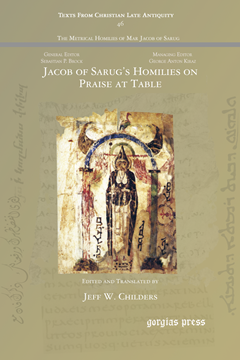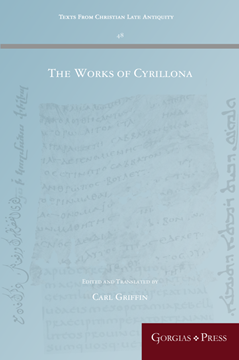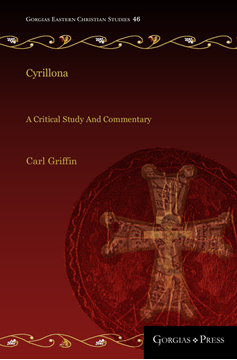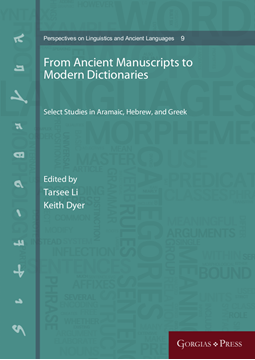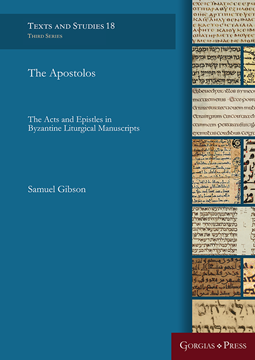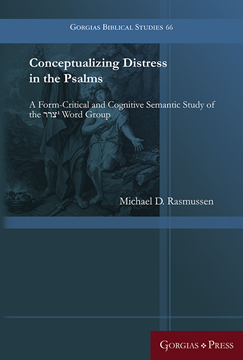Jacob of Sarug's Homilies on Praise at Table
Edited and Translated by Jeff W. Childers
Series: Texts from Christian Late Antiquity 46
ISBN: 978-1-4632-0605-5
Part of a series of fascicles containing the bilingual Syriac-English editions of Saint Jacob of Sarug’s homilies, this volume contains his homilies on Praise at Table. These homilies offer a glimpse into the efforts of one late antique author to construct distinctly Christian meaning from the experience of communal meal-sharing. The Syriac text is fully vocalized, and the translation is annotated with a commentary and biblical references. The volume is one of the fascicles of Gorgias Press’s The Metrical Homilies of Mar Jacob of Sarug, which, when complete, will contain all of Jacob’s surviving sermons. Recognized as a saint by both Chalcedonian and non-Chalcedonian Christians alike, Jacob of Sarug (d. 521) produced many narrative poems that have rarely been translated into English. Of his reported 760 metrical homilies, only about half survive.
$47.00 (USD)
The Works of Cyrillona
Edited and Translated by Carl Griffin
Series: Texts from Christian Late Antiquity 48
ISBN: 978-1-4632-0606-2
Cyrillona (fl. 396) has been ranked among the foremost early Syriac poets since his work was rediscovered by scholars in the mid-19th century. His Holy Week discourses on the Last Supper, the Washing of the Feet, and the Institution of the Eucharist have become particularly well-known to western readers through quotations by such diverse authors as Hugo Rahner and Photina Rech. This volume presents the first modern critical edition of Cyrillona’s Syriac works together with the first complete English translation.
$60.00 (USD)
Cyrillona
A Critical Study and Commentary
By Carl Griffin
Series: Gorgias Eastern Christian Studies 46
ISBN: 978-1-4632-0607-9
Cyrillona (fl. 396) was a younger contemporary of Ephrem the Syrian whose work has been celebrated as comparable in both beauty and its significance for our understanding of early Syriac Christianity. This study reassesses conventional claims about the author’s identity, date, and the constitution of his corpus. It introduces each of Cyrillona’s five surviving poems and examines their poetic form and genre, structure and rhetorical features, and critical questions of text, interpretation, and theology.
$169.00 (USD)
From Ancient Manuscripts to Modern Dictionaries
Select Studies in Aramaic, Hebrew, and Greek
Edited by Tarsee Li & Keith Dyer
ISBN: 978-1-4632-0608-6
These articles on Aramaic, Hebrew, and Greek lexicography have arisen from papers presented at the International Syriac Language Project's 14th International Conference in St. Petersburg in 2014.
$211.00 (USD)
The Apostolos
The Acts and Epistles in Byzantine Liturgical Manuscripts
Series: Texts and Studies (Third Series) 18
ISBN: 978-1-4632-0609-3
Lectionary studies were almost abandoned after the mid-twentieth century, and the recent revival of interest in the Greek Lectionary has concentrated exclusively on the Gospel Lectionary. Gibson reintroduces the value of the Apostolos yet incorporates modern methodology in order to build upon the work of recent Lectionary scholarship, analysing New Testament and liturgical textual traditions together, both compilation and continuous text. Through this process, it is shown that the Apostolos witness is not usually copied to another and that consequently there is no ‘Lectionary text’ of Acts and Paul. Instead, Apostolos copies reflect textual variation in the evolving Byzantine tradition. This study concentrates on the Apostolos in its scribal, monastic, liturgical, and theological context as well as in light of other manuscript traditions.
$166.00 (USD)
Conceptualizing Distress in the Psalms
A Form-Critical and Cognitive Semantic Study of the צרר1 Word Group
Series: Gorgias Biblical Studies 66
ISBN: 978-1-4632-0610-9
Psalms containing lexemes derived from the Hebrew root צרר (to bind, be in distress) reveal a previously-unnoticed generic subgroup in the Psalter. Through structural and cognitive linguistic principles, Rasmussen explores issues related to genre, Hebrew grammar, and syntax in order to arrive at a set of three cognitive domains of “powerlessness,” “palpable threat,” and “entreaty” which are relatively unique to psalms that include צרר lexemes. Rasmussen also makes suggestions about the editorial process of the Hebrew Psalter, concluding that after the Babylonian exile, distress was more strongly associated with divine discipline and displeasure, whereas before the exile it was more associated with declarations of innocence.
$114.95 (USD)
